Markus Boßlet, Restaurant Bar
Mit vielem Dank an Markus Boßlet, Küchenchef und Inhabe des Restaurant Bar in Siegen, der sich so großzügig Zeit nahm und Jakobsmuscheln “Ras El Hanout” und ein herbstliches Calamari-Risotto für mich kochte.
Mit vielem Dank an Markus Boßlet, Küchenchef und Inhabe des Restaurant Bar in Siegen, der sich so großzügig Zeit nahm und Jakobsmuscheln “Ras El Hanout” und ein herbstliches Calamari-Risotto für mich kochte.
Einladung zur Adventsausstellung von Linh Duong in Siegen. Photographie, Gestaltung und Druck der Postkarten.
Zu Besuch in der Siegener Kaffeerösterei Pagnia.
Zu Gast in der Geigenbauwerkstatt des Siegener Geigenbaumeisters Clas Reimers.
Today I received TRAUMA, a beautiful and very personal gift from Austrian painter Christian Bazant-Hegemark, for which I am deeply grateful. The volume spans fifteen years and tells the story of searching for a visual language dealing with trauma.
I was surprised how many of the paintings and drawings I still knew from my time in Vienna, some of which even appear in portraits I took in 2013.
Im Herbst 2014 hatten Julia und ich das große Glück, am Dachstein ein Retreat mit Coach und Trainer Hans-Peter Beingrübl von Pushkar Nature verbringen zu können. Sein großes Wissen und seine reiche Erfahrung ruht in seiner allgemeinen Entspanntheit, so dass sich in einem wirklich angenehmen Rahmen ein paar erstaunliche Dinge in Gang setzten.
Nach einer Nacht im Freien ohne Zelt und einer von Apfelstrudel und Freundlichkeit geprägten Nacht auf der Gjaid bei Isi, Hannes und Indra, einer Tour fast auf den Gjaidstein, viel Nebel, einem weiten Blick vom Zwölferkogel und vor der Kulisse des wunderschönen Dachsteingipfels reiften weitreichende Entscheidungen. Und als wir wieder hervorkamen aus dem Gebirgsnebel stand am Ende der Satz »Ich kündige!«.
Am Samstag, 28. April 2020 spielte Jördis Tielsch gemeinsam mit Peter Schneider ein Benefizkonzert im Kulturhaus Lÿz.
Möglich wurde die Veranstaltung trotz Corona dank des virtuellen Hutes – einer Initiative, die zusammen mit dem Kulturbüro des Kreises Siegen-Wittgenstein lokale Künstler und Kulturschaffende unterstützt und in Zeiten des Kontaktverbots heimische Kultur in die Siegerländer Wohnzimmer bringt.
Setting up my Raspberry Pi. Experiences with crunchbang, ubunutu, bunsenlabs help, but in Raspbian some things still are slightly different, namely:
Autostart file is at /etc/xdg/lxsession/LXDE-pi/auto. Add programmes preceded by “@”
Academic publishing can sometimes be pretty much of a one way radio: You’re broadcasting but you never know whether or not someone is receiving – and if someone is receiving, what they make of it.
So I am happy that Dr Dominik Zink of the University of Trier took the time to read and kindly review my PhD Thesis in The Year’s Work in Modern Language Studies 79 (2019) 1, p 555 (published online on 28 March 2019 at https://brill.com/view/journals/ywml/79/1/article-p555_41.xml).
My NextGen gallery kept vanishing on my WordPress frontpage. It did not show as long as the page was set to front page, as soon as I picked a different front page, the images reappeared. Even when I changed the theme, the gallery disappeared.
I checked and rechecked the source code, but what I apparently missed was the gallery being wrapped in auto excerpt tags:
In a possible world I would live in the old family farm by the forest. I’d have a wood fired oven, plenty of vegetables and fruit from the garden and more space in- and outside the house than I could possibly fill. I would eat my home baked bread for breakfast in the old chicken yard while enjoying the most stunning view over the Weser-valley.
I’d also have had an idea why I would and could live in the sticks, I’d have had another idea that would fill ex-barn and ex-stable with something sensible – preferably something sensible and income-generating so it would provide me with yet another idea on how to pay for maintenance of the gigantic roof.

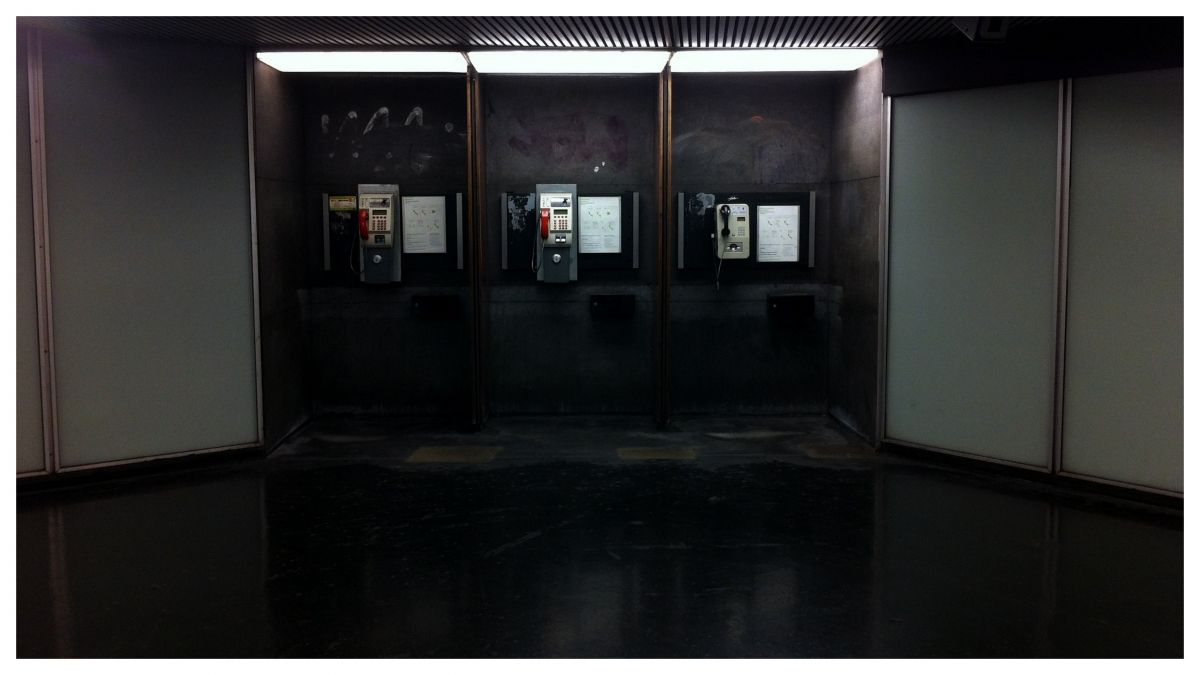

Toilets, Camping »La Pinède, Calvi (Corsica), May 2017
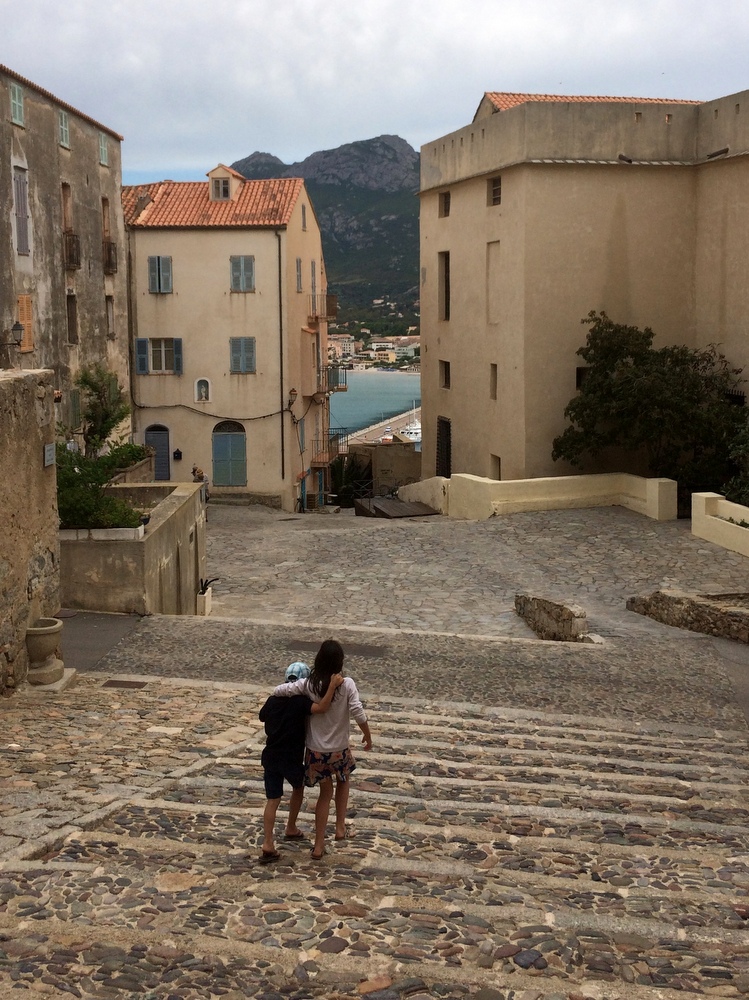
Brother and sister, Calvi (Corsica), May 2017
Universal Plug and Play (UpnP) is developed by the Digital Living Network Alliance (DLNA) and has interoperateability in mind. See Make Use Of for a list of possibilities.
Client: pick one from http://www.subsonic.org/pages/apps.jsp. VLC also works as a client, see https://askubuntu.com/a/109083/80611
I use play:Sub, another $5
I also tried Gerbera
Easy, cheap, but flawed.
Hat tip: Lifewire
Interestingly it was easier to setup video streaming than audio (use vlcstreamer, see upubuntu).
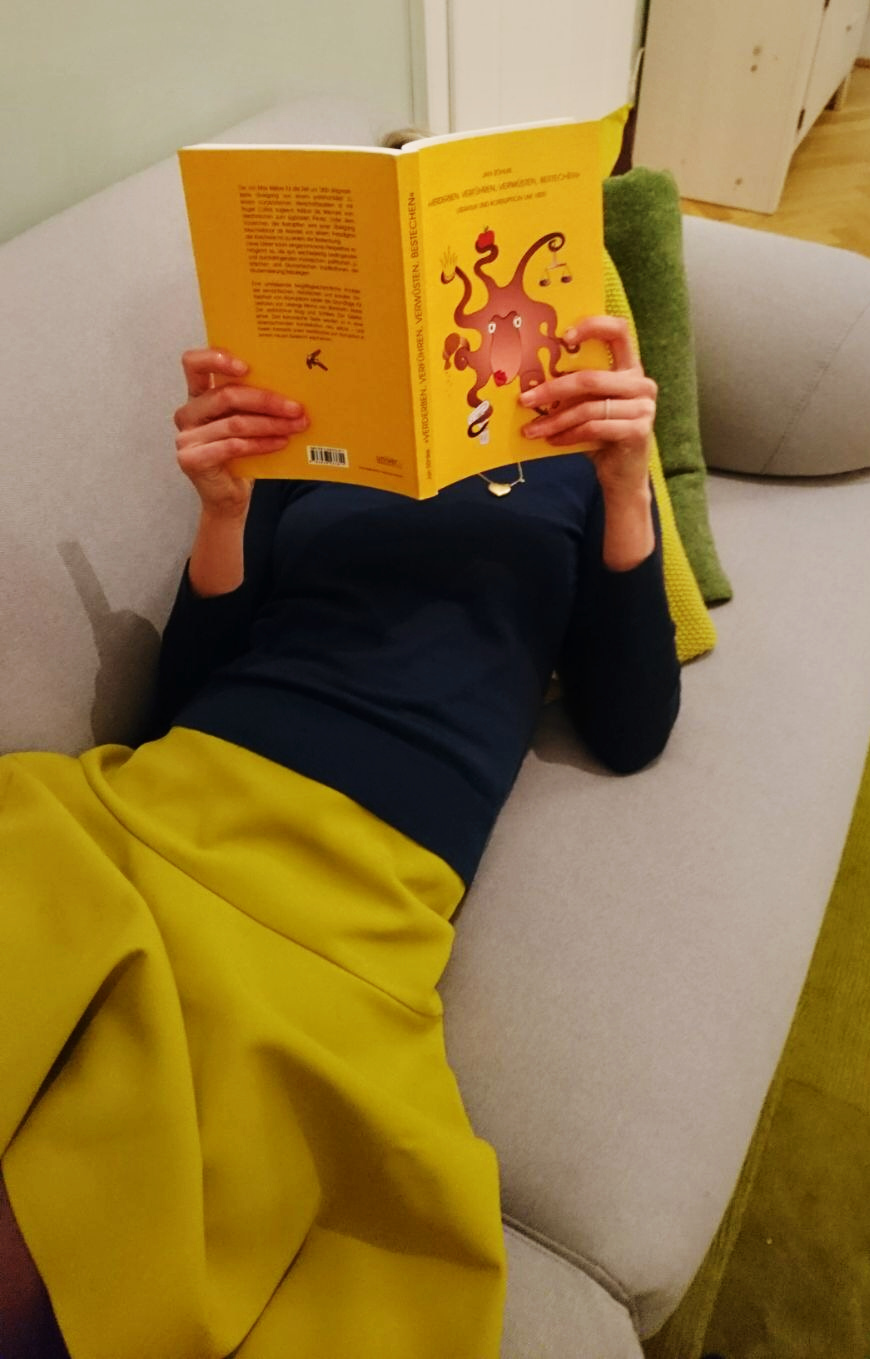
After several applications and interviews in Vienna, Walferdange, Berlin and Munich I settled on Munich. So in June 2012 I began writing properly while commuting from Vienna to Munich every other week. My »office« was in the Arbeiterkammer library and the Ludwig-Wittgenstein-Lesesaal in the Austrian National library.
In October 2015 I was ready and submitted the thesis.
You should think there is a sensation of great relief when you finally hand the work of three plus years over to the officer, but somehow there wasn’t. My defense was going to be in February 2016, so I started preparing the three talks I had to give straight away.
Now, with the defense out of the way, there still was no sense of accomplishment, because you have to publish in order to close the process. So off we go to finding a publisher, setting up the text according to the publisher’s style guides, resetting tables and trees because they don’t fit on the smaller pages any more, brainstorming a cover image with Marianne Vlaschits, test printing and changing the cover three dozen times because the digital printer does not approve of the background color. Then seeing the table of contents in a friend’s brand new book and going back to my own because I absolutely wanted one like it. And on and on.
In the end, thanks to the knowledge, understanding and patience of the good people at UniPrint Siegen, there is a finished product that does make me happy – but still fails to deliver the wash of relief. Because now five books have to get to Munich university library, where the people are not happy. My books lack the title page the faculty requires. When that is adressed, I get told to contact the officer who received the first version in 2015 again in four to eight weeks for the certificate. Which I recieved two weeks ago. The End.
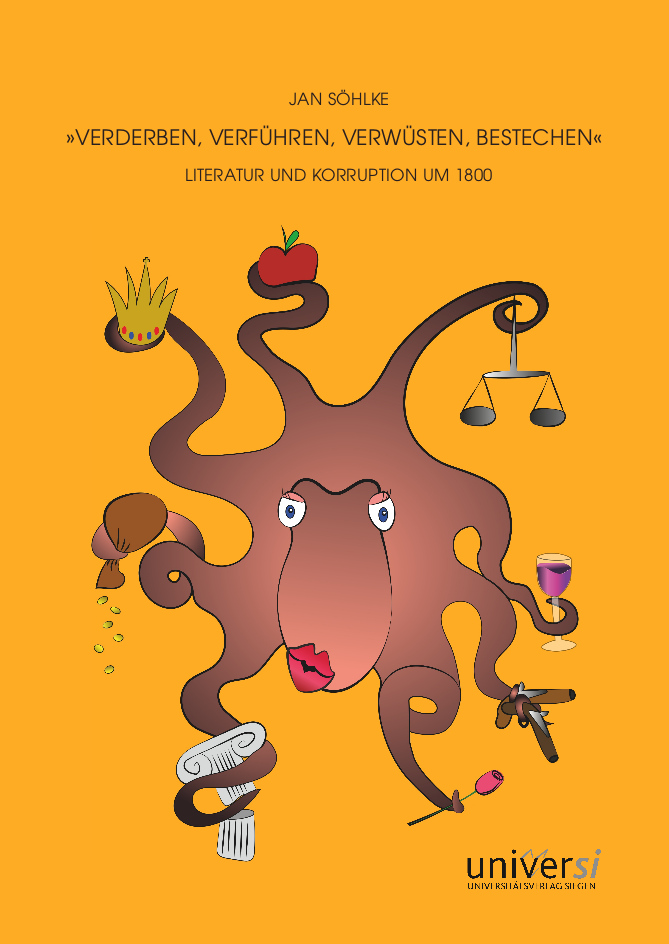
Here it is:
Jan Söhlke: »verderben, verführen, verwüsten, bestechen«. Literatur und Korruption um 1800. Siegen 2017, 284 pages.
ISBN: 978-3-936533-81-1
For EUR 12.80 you can order the book at universi (Siegen University Press), you can download it from OPUS (Siegen university’s open access) for free or get it from the source while you’re here.
The back cover reads
Der von Max Weber für die Zeit um 1800 diagnostizierte Übergang von einem patrimonialen zu einem bürokratischen Herrschaftssystem ist mit Roger Callois zugleich faßbar als Wechsel vom aleatorischen zum agônalen Prinzip. Unter dem Vorzeichen der Korruption wird jener Übergang beschreibbar als Wandel von einem Paradigma der Kriecherei hin zu einem der Bestechung.
Diese bisher kaum eingenommene Perspektive ermöglicht es, die sich wechselseitig bedingenden und durchdringenden moralischen, politischen, juristischen und ökonomischen Implikationen der Modernisierung freizulegen. Eine umfassende begriffsgeschichtliche Analyse der semantischen, historischen und sozialen Verfasstheit von »Korruption« bildet die Grundlage für Lektüren von Lessings Minna von Barnhelm, Kleists Der zerbrochne Krug und Schillers Der Geisterseher. Drei kanonische Texte werden so in einer überraschenden Konstellation neu lesbar – und lassen ihrerseits unser Verständnis von Korruption in einem neuen Zwielicht erscheinen.
sudo apt-get install sqlitebrowsercd ~/.local/share/data/Mendeley\ Ltd./Mendeley\ Desktop/sqlitebrowser <you@whatever>@www.mendeley.com.sqliteupdate Files set localUrl = replace(localUrl, 'file:///old/path/‘, 'file:///media/new/path/‘);
Thanks to 3.14a and jordi’s comment there. For related Mendeley grievances see khufkens, who can tell you how to sync Mendeley to your own server (instead of feeding Elsevier’s questionable pricing model).

Anyway, the whole setup was a true Linux afternoon, reminding me of my NDISwrapper-days, just like it was 2006 again.
First, It took me a while to get crunchbang to discover the device and connect [1] (Blueman works much better as a bluetooth manager). Then apparently I manually needed to let pulseaudio know where to send the audio [2]. Atfer fiddling with some files, pulseaudio was broken, so I needed to reinstall [3]. Finally, the sound was much poorer than via my phone. I don’t know if I overlooked it or if loading rtirq changed something [4], but in the volume control center of pulseaudio there is a tab called »configuration« where I had to choose »High Fidelity Playback (A2DP)« to get decent sound (instead of »Telephony Duplex (HSP/HFP)« or »off«). Now most of the times it changes to the Bluetooth-device automatically once I switch it on and back when I switch it off. Sometimes not. But hey.
The sources I used were these:
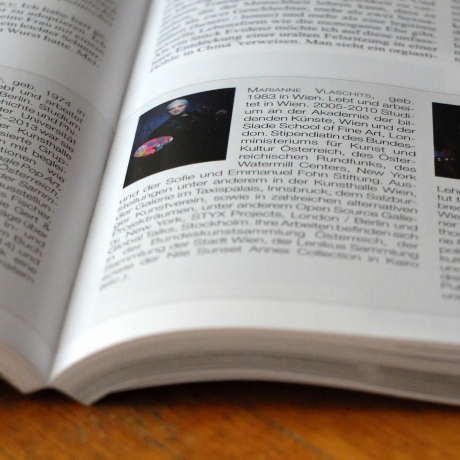
A short while after my last portrait session with Marianne Vlaschits, KUNSTFORUM International did an interview with her and two fellow artists and she used one of my portraits to go with the interview.
When asked whether he wrote on a schedule or only when struck by inspiration, Somerset Maugham allegedly replied:
I write only when inspiration strikes.
Fortunately it strikes every morning at nine o’clock sharp.
»It’s the 499 birds before the 1 that works.« (Alexia Sinclair/via)
or, in the words of Jacob Riis:
When nothing seems to help, I go look at a stonecutter hammering away at his rock perhaps a hundred times without as much as a crack showing in it. Yet at the hundred and first blow it will split in two, and I know it was not that blow that did it, but all that had gone before. (via)
I did not have my gear with me and there only was an hour left in between the idea to go for the shoot and me having to be through the door for the train station, so in order to put the opportunity to good use we had to move fast and I had to borrow Marlene’s old Canon. Of course time was even scarcer after the usual displacement of furniture had taken place, and the combination of time pressure, borrowed equipment and a different camera maker resulted in a couple of technical blunders on my part, but we all had a fun time and in the end were pretty pleased with the results.
Das im Februar beschlossene Gesetz gegen Abgeordnetenbestechung ist weitgehend wirkungslos. Ein Staatsanwalt muss nämlich nachweisen, dass ein korrupter Volksvertreter »im Auftrag oder auf Weisung« gehandelt hat. Wer sich nicht allzu dumm anstellt, hat strafrechtlich nichts zu befürchten.
The law against bribing of MPs is mostly useless as prosecution has to prove that a corrupt representative has been »either instructed or ordered« to act in a certain way. For the slightest chance of criminal liability under the new law, a parliamentarian would need to act in a pretty stupid way.
abgeordnetenwatch.de: Bundestag ratifiziert UNCAC – nach 11 Jahren (29. September 2014)
Some background can be found in my earlier post »Bribing MPs soon illegal in Germany«.
My friend and colleague Doc Babel not only taught me rudimentary Spanish, he and his wife also provided me with a home in Munich during the last few years, which made many things easier than they easily could have been.
And now that it’s their turn to look for a new home, they pack some aluminum boxes bound for South America and thought that some decent head shots would make their new start easier. I was of course more than happy to provide that part of their luggage.
What I get when I come home is file names looking like this: _DSC1234.NEF. What I wanted instead was
looking like this: 20140708_WeddingAdamAndEve_0001.NEF
There are a few issues with this:
ad 1. Date Shot: sometimes I can only copy and rename the files a few days after shooting, so the date should reflect the date the picture was taken, not the date it was copied. Getting date-shot from the file itself is difficult as there is no birth time recorded. The closest is mtime which is the time the file’s content has last been modified. However, creation date is stored in image file’s EXIF data.
ad 2: Name of Shoot: Ideally I wanted this to be a variable I could set as a parameter when calling the script.
ad 3. Number of Image: This should reflect the age of the image with the oldest one having the lowest number. The problem is that cameras usually restart numbering at 0000 once they hit 9999. So images n-9999 can potentially be older than 0000-n. I needed a solution that would cater for this special case.
# original solution by @Gilles (http://unix.stackexchange.com/questions/141138/) # set base path and navigate to "basepath + parameter 1" BASEPATH='/media/data/photo/'; cd $BASEPATH$1 # add "EXIF creation time" as prefix to original file names exiv2 mv -r %Y%m%d-%H%M%S:basename: *.NEF # Now we have files with names like 20140630-235958_DSC1234.NEF. # final rename i=10000 for x in *.NEF; do i=$((i+1)) mv "$x" "${x%-*}_$2-${i#1}_Copyright-Jan-Soehlke.NEF" done
Walkthrough
Line 4: Here we set our base path. We choose the highest directory ever useed to store pictures.
Line 5: Navigate to base path + parameter 1. If our script is called rename and the pictures are in /media/data/photo/weddings/adam+eve, then we call the script through
./rename weddings/adam+eve
Line 8: In a first iteration we add EXIF-creation time as a prefix to the original file names. We use exiv2 for this operation. -r is for rename and we use YYYYMMDD-hhmmss, which is %Y%m%d-%H%M%S in strftime(3), plus :basename: to keep the original filename after the time stamp.
Through creation time as a prefix we now sort files by age, even if the files would sort differently by name. This could happen if during a shoot we reach 9999 and the camera’s counter continues at 0000 or if we shot with two different cameras.
By also retaining the original file name for now, we make sure that in case there are multiple files with the same time stamp, they still have individual names. EXIF time’s finest unit is a second, so if we fire bursts of images (Nikon’s D4s for example shoots at 11 frames/second), we have multiple files with the same creation date and thus potentially 11 files with the same name.
Line 12: The counter variable i counts from 10000 and is used with the leading 1 digit stripped; this is a trick to get the leading zeros so that all counter values have the same number. If you want more (or less) than four digits, set i accordingly.
Line 15: ${x%-*} removes everything that follows the - character, in our case it is hours, minutes and seconds as well as the original filename. ${i#1} writes the new four digit file number.
$2 provides a second variable, which we use for the shoot name. In this case we want it to be WeddingAdamAndEve, so we call the script through
./rename weddings/adam+eve WeddingAdamAndEve
Finally, I added _Copyright-Jan-Soehlke. It not only reminds someone who downloads the file that it is indeed copyrighted, it also helps with SEO as my name is automatically associated with each image I upload.
Possible Problems
a) The original file names already have a
-in place. In this case change the - in line 8 to something different (like _) and use the same character in the ${x%-*}-part in line 15 (in this case ${x%_*}, otherwise the script will not work as intended.b) A burst of images reaches across the
9999/0000-mark. These specific files will not be in order after renaming – but they weren’t in order in the first place, so I have no idea how to tackle this rare scenario other than by setting your camera’s counter to reset to 0000 after each formatting.c) Your files do not contain EXIF data. In this case see mikeserv’s solution which uses a different angle of attack and is thoroughly and well explained.
___________________________
* Stackexchange uses the CC-BY-SA license, so all the code in this example is naturally also CC-BY-SA.
Once again I learned that photography sometimes is like cooking: when you want to try something exciting for the first time, don’t do it in the presence of important guests. But I also learned that in Marianne’s presence, failing means that in the end it still is going to be an awesome afternoon resulting in pictures we both like – good to work with a professional. And just like Beckett writes: »Ever tried. Ever failed. No matter. Try again. Fail again. Fail better.«
I am also happy about the three derivative works that came from the shoot: a portrait of the photographer by Marianne (seen in pictures 4 + 5); a Feiyue »Vlaschits Edition« by me (from slipping on paint) and »Painting the Artist« by Hyo Lee.
And despite my clumsiness (that not only led to Feiyue »Vlaschits« but also saw a falling SB 800 just miss Marianne’s head), the Comme des Garçons-robe Marianne’s neighbour and fashion designer Thomas van der Jeught gave us in his infinite trust stayed clean.
Next Monday (23.6.2014) at the Archiv für Gegenwart (Mühlfeldgasse 5, 1020 Wien) you have the opportunity to see Marianne Vlaschits – who by the way is also responsible for the highly acclaimed cover art of Hercules and Love Affair’s latest album The Feast of the Broken Heart.

I pondered and wondered what to do – since I did not yet start a formal business as a photographer, I did not know whether or not I could just bill them – and if so: how much? Also, I feared the conundrum that would possibly result from it regarding my taxes: billing would once again give me a »world income«, additionally complicating matters by being employed as a researcher in Germany plus effectively becoming a self employed photographer in Austria. I figured I needed a lawyer, yet despite soon learning that the Rechtsanwaltskammer is offering free first advice, I did not find (= make) the time going there.
Then I read »Would You Die For The Photo?« by Chase Jarvis (warning: graphic images), it led me to war photographer James Nachtwey’s talk at TED where he mentions working with Médecins Sans Frontières. Their work and courage impress me a lot. I also remembered that whenever a corporation uses a Tom Waits song for advertising, he sues them to then donate all the money he receives.
I thought I should try the same thing (if on a much smaller scale) and posted a registered letter a week ago, requesting a donation of EUR 150,– to MSF in my name. And voilà, today I receive this:

According to MSF, 150 EUR buy food for 15 malnourished children for two weeks or treatment for 300 children with pneumonia or 6 weeks basic medical services for 400 refugees. Donations can be made here.
This video introduces him:
Here you can see him work at his »American Dream« series:
In this clip about Madison (who was born weighing only 800g) he also uses his »time machine« for film:
Ian was a guest at Chase Jarvis Live (you can see what is going on inside the camera from 1h38m35s):
Images are on Ian’s website and his tumblr.
Thanks to the generosity of NHM’s communication department, I was lucky enough to receive an invitation for the opening function/book presentation last Tuesday. Apart from recommending to go and see the exhibition (until September) I took away some food for thought from the opening talks.
Christian Köberl, the museum’s director, explained how the Natural History Museum – an institution that is widely associated with stuffed animals and a vast collection of rocks – came to host an exhibition covering a problem that is clearly man-made. He linked it to two other exhibitions currently on display: Trading in Death – the Final Mass Extinction? has the commercial interest and its impact on nature as a common denominator. Experiment Life – Gabonionta overlaps as it shows the oldest complex life forms known to man, which share the time and the place (Gabon, 2.1 billion years ago) of a highly above average activity in natural nuclear chain reactions similar to the counterparts in man-made reactors nowadays. Whether there is a causal link to the advent of the first complex, colonial organisms is unclear but interesting.
The museum can shape the context and thus shape perception. By putting three different, seemingly unrelated temporal exhibitions on at the same time, a very constructive overlapping is created – interferences come into being simply through putting three seemingly unrelated things next to each other.
Lois Lammerhuber (of the book’s publisher Edition Lammerhuber) recounted the media reception. Despite the lack of a Chernobyl jubilee, all the important news outlets had already covered the publication and exhibition. When he asked German state TV, who filmed for two hours in the exhibition, why they were doing it, they answered: »Weil ein Buch erscheint« (»because a book is being published«, where the German »erscheinen« can both refer to an »appearance« as well as an »epiphany«). Lammerhuber was visibly impressed by how he, in letting a book appear, can force something onto the agenda of a world that would otherwise not have taken notice at that point in time.
As the two preconditions he identified Ludwig’s willingness to commit to such a long term project and his capability to make something visible.
Gerd Ludwig gave a few insights into the way he works. Even though the subject of his images is suffering and destruction, the are aesthetically pleasing. Aesthetics to him is the grammar of photography.
He views the fact that he does not have to work under a tight time constraint as his biggest privilege because it means that he can talk first and then take the pictures. The trust he establishes through the conversations greatly helps reduce the momentary amplification of suffering he inevitably causes by taking a picture.
He finished by telling a story from Sicily: one night an enormous number of starfish were washed ashore. In the morning, when the sun rose, they started to dry out and die. The children of the village noticed and started carrying them back to the water. An older man from the village stood and watched and said: »you can’t save them all, your enterprise is futile – the little you can do doesn’t make a difference«. One child, holding up a single starfish, replied: »And yet for this one, it does make a difference«. Ludwig wants to be this child always.
Finally, the section chief Michael P. Franz closed the circle Christian Koeberl established by opening the exhibition with a Gottfried Boehm quote: an image, he says, pre-formulates the access to our world.
A slightly outdated version is in debian’s repositories, but if you want a newer one, go to »Kbyte’s Hideout«. Download .deb package and dpkg -i rawtherapee_<xxx>.deb
If there are unsolved dependencies: apt-get install -f and then dpkg -i rawtherapee_<xxx>.deb
Well.
It still is the most straightforward programme I know for editing, simple retouches and exporting smaller sizes. I’m not happy with wine, I’m not happy with a google tool, but I cannot and cannot find an alternative (see here). Hence:
before following the webupd8 tutorial I needed
apt-get install libwine-cms:i386
After installation, use
cd ~/.wine/drive_c/Program\ Files/Google/Picasa3 && wine Picasa3.exe
to launch it.
If you would then create a script called »picasa« somewhere, say in ~/scripts containing the following:
#!/bin/bash cd ~/.wine/drive_c/Program\ Files/Google/Picasa3 &amp;amp;&amp;amp; wine Picasa3.exe exit 0
Picasa can then be launched from command-line with a simple »picasa« after a final
sudo ln -s ~/scripts/picasa /usr/bin/picasa
To change the format from Hour:Minute open ~/.config/tint2/tint2rc and consult strftime-man to change to your liking.
Keyboard shortcuts can be changed in ~/.config/openbox/rc.xml
After saving, go to Openbox menu > Preferences > Openbox Config > Reconfigure. (Thanks, MysteryMember)
Polypager’s strength clearly was in handling the database – it has foreign key capability and without the faintest complaint, Polly will display any mysql-database it is being fed. However, it was never built with serving images as a central part in mind. There is a gallery plugin in place, but my desires soon surpassed the capabilities.
Zenphoto in turn is fantastic in handling text and images (and video by the way, which surprisingly posed the biggest hurdle in wordpress – the other was 301, but in the end Tony McCreath’s redirect generator helped). The problem with zenphoto is more an aesthetic one as the available skins are limited and don’t really meet my expectations. The one I hacked together unfortunately »grew organically« over the years until recently it gracefully started falling apart.
Thus, today I make the move to WordPress and while I am at ease parting from Zenphoto, leaving Polly behind really hurts. So, thanks Nic for developing it and having me aboard, because in the process, I learned many a thing about distinguishing sensible feature requests from the other ones, about version management using svn and git, and also, in 2008, about how it feels to be at the receiving end of a proper hack.